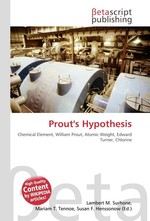Prouts Hypothesis
Lambert M. Surhone, Mariam T. Tennoe, Susan F. Henssonow
бумажная книга
Please note that the content of this book primarily consists of articles available from Wikipedia or other free sources online. Prout's hypothesis was an early 19th century attempt to explain the existence of the various chemical elements through a hypothesis regarding the internal structure of the atom. In 1815 and 1816, the English chemist William Prout published two papers in which he observed that the atomic weights that had been measured for the elements known at that time appeared to be whole multiples of the atomic weight of hydrogen. He then hypothesized that the hydrogen atom was the only truly fundamental object, and that the atoms of other elements were actually groupings of various numbers of hydrogen atoms. Prout's hypothesis remained influential in chemistry throughout the 1820s. However, more careful measurements of the atomic weights, such as those compiled by Jons Jakob Berzelius in 1828 or Edward Turner in 1832, disproved the hypothesis.
Данное издание не является оригинальным. Книга печатается по технологии принт-он-деманд после получения заказа.


